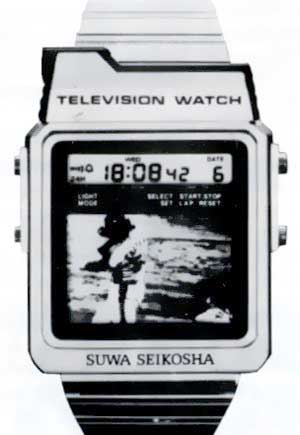
"Already,
the science fiction writers' dream has become a reality with the
wristwatch TV from Seiko - again, it will be around a year before it
appears in shops in the UK."
This appeared on Tomorrow's World at the time. It was underwhelming.
From what I remember, the aerial and batteries were stored outside the
watch, in a small box that was kept in a shirt pocket. And the picture
quality was very poor. It did however reach the market, and remains
a cult 80s consumer tech item nowadays, like Sinclair's 'Black Watch'
or the Fisher-Price 'PXL-2000' video camera (which used audio cassettes
to store footage and had a ghostly, grainy image quality).
Tiny LCD televisions became affordable at the turn of the
90s, although they had the same problems as the television watch above -
reception was poor, battery life was limited, and whereas radio is divided
into bite-sized musical chunks, it's not comfortable to watch half-hour /
hour-long television slots on a screen the size of an apple. MTV might be
appropriate, but that's only available via satellite and
cable.
Nowadays the big news in television technology is the
full-sized flat-panel LCD display. Sinclair and other companies were
convinced that they were on the verge of marketing such devices in the
early-80s - in reality, a 21" widescreen LCD television costs over £5,000
in 2001, and, in 1983, the market for such a thing would have been
restricted to NASA, JPL, Strategic Air Command, and perhaps the US Navy,
for use in submarines.